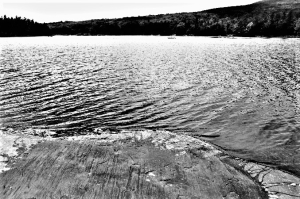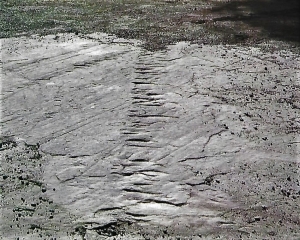Alien visitors at Site 151
On the Rocks
The Woodstock Times
Robert and Johanna Titus
We have written so many columns about the North Lake area. We just never seem to run out of topics and we continue to find new ones all the time. There is a reason for that; North Lake (and South Lake too) is a geological wonderland. Have you been there? It’s time! You take Rte. 23A and drive up Kaaterskill Clove. That’s an adventure all by itself. You watch for the right turn that takes you onto County. Rte. 18 which is also known as the North/South Lake Road. You follow the road until you enter the park and proceed onward until you get to the North Lake parking lot.
Now comes the hard part; you have to walk down to the shore of North Lake and head north. You want to enter into the campground and you, specifically, want to locate campsite 151. We can’t offer much advice about that, but we did it so you can too. Along the way, we want you to be looking at the bedrock exposures. There are a lot of good ones right along the edge of the lake. It won’t be hard to notice that there are a lot of long straight scratches in the rock surfaces.
If you have been a long time reader then you know what we are talking about. These are glacial striations. They were etched into the rocks more than 14,000 years ago, near the end of the Ice Age. What happened was that a glacier flowed by. It was dragging a large amount of sand with it, and that sand acted like the sand of sandpaper. It was scraped against the bedrock and that gave those surfaces a smooth polished look. Then, the moving ice brought pebbles and even cobbles along. Those dragged bottom and did the etching; those striations were the results.
You learn a lot more by measuring the compass directions of those striations. Most all of them are aligned with a southwest orientation. They speak to us of a mass of ice moving in the direction of South Lake. The ice had risen up out of the Hudson Valley and moved, ever so gradually, to the Northwest. Along the way, it had polished and striated the rock. Take a look at our first photo. The striations are seen in the shoreline rocks. All of them are aimed at the distant location of South Lake.

It did something else; it scoured out North Lake itself. The lake’s basin is a direct product of the movement of this glacier at that time. This has been known to geologists for a very long time. We wonder who the first geologist to recognize this was. We don’t know; that discovery has been lost to history. What a moment it must have been. In a flash, some expert and observant geologist had figured out the very origins of North Lake. And that person had discovered a very good story to tell. The lake’s basin had been scoured out by an advancing glacier.
Well, we think we have a story to tell that is nearly as good. Remember site 151? Let’s go back and find it. That campsite has an expansive stretch of exposed bedrock abutting it. It’s a broad platform of flat rock, perhaps a quarter acre in size. That’s big for an outcropping and it is also quite flat. There are reasons for this.
This fine exposure is a product of the same ice that carved those striations along the lakeshore. It was that moving ice that had bulldozed the landscape here to expose all that rock. It was that glacier that had beveled the rock down to make it so flat. And there is more; there are some very fine striations exposed here. Back during the Ice Age, Site 151 had received some alien visitors; they were glaciers which had originated all the way north, as far as Labrador.
And there was more than just one set of visitors. There is a second set of markings on these rocks. Take a look at our second photo. It’s the site 151 bedrock. You will see a number of striations and those are all oriented going away from our viewpoint. But there is a second set of markings; they are a series of crescent shaped fractures that cross the striations at an angle of about 30 degrees. That’s from the lower right to the upper left. These are most commonly called crescent marks. They record a younger glaciation. A younger mass of ice was crossing over the same outcropping, but this one was advancing at a different compass direction.

These crescents record that this glacier was carrying a boulder within it. The weight of the ice tried to hold the boulder down, but the shove from behind tried to advance it. Something had to give, and when the shove from behind was great enough, the boulder leaped forward and impacted the rock. Each leap forward created one crescent in the series that we see in the photo.
That quarter acre of exposed rock records two episodes of advancing ice – two glaciers, one after the other. That’s history – ice age history.
Contact the authors at randjtitus@prodigy.net. Join their facebook page “The Catskill Geologist.” Read their blog at “thecatskillgeologist.”





